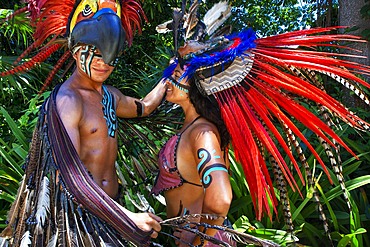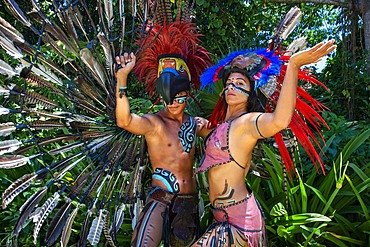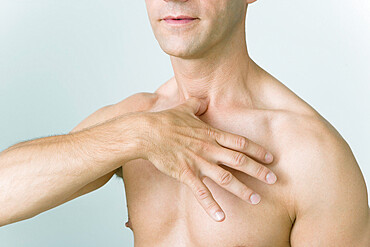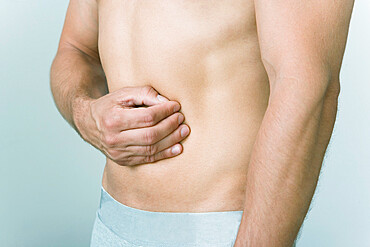Recent searches
Loading...
1350-6608 - Mexican aztec dress gods at Grand Palladium White Sand Resort and Spa in Riviera Maya, Yucatan Peninsula, Quintana Roo, Caribbean Coast, Mexico.
Aztec clothing was generally loose fitting and did not completely cover the body. When the Spanish arrived in Mexico, the people were surprised to see them in their full armour, with only their faces exposed.
Aztec clothes were generally made of cotton (which was imported) or ayate fiber, made from the Maguey Cactus (also called the Century Plant or American Aloe). Women would weave the fibers into clothing, a task girls were taught as young teenagers. Because of their vast trading network, the Aztecs were able to make use of a beautiful array of dyes, creating the brilliant
1350-6595 - Mexican aztec dress gods at Grand Palladium White Sand Resort and Spa in Riviera Maya, Yucatan Peninsula, Quintana Roo, Caribbean Coast, Mexico.
Aztec clothing was generally loose fitting and did not completely cover the body. When the Spanish arrived in Mexico, the people were surprised to see them in their full armour, with only their faces exposed.
Aztec clothes were generally made of cotton (which was imported) or ayate fiber, made from the Maguey Cactus (also called the Century Plant or American Aloe). Women would weave the fibers into clothing, a task girls were taught as young teenagers. Because of their vast trading network, the Aztecs were able to make use of a beautiful array of dyes, creating the brilliant
1350-631 - Rhynchophorus ferrugineus or red palm weevil; it is killing all palm trees in Spain, originary from South east Asia it is believed it came to Spain in some imported palm trees from Egypt
1350-630 - Rhynchophorus ferrugineus or red palm weevil; it is killing all palm trees in Spain, originary from South east Asia it is believed it came to Spain in some imported palm trees from Egypt
1348-1091 - The Do In is an automassage technique of chinese origin, then imported in Japan. This technique is based on the pressure of certains points (acupressure) aiming at correcting body disorders. Pinch the nape going down. Aim : relieve torticolis.
1348-1089 - The Do In is an automassage technique of chinese origin, then imported in Japan
1348-1088 - The Do In is an automassage technique of chinese origin, then imported in Japan
1348-1096 - The Do In is an automassage technique of chinese origin, then imported in Japan
1348-1082 - The Do In is an automassage technique of chinese origin, then imported in Japan
1348-1084 - The Do In is an automassage technique of chinese origin, then imported in Japan
1348-1086 - The Do In is an automassage technique of chinese origin, then imported in Japan
1348-1099 - The Do In is an automassage technique of chinese origin, then imported in Japan. This technique is based on the pressure of certains points (acupressure)
1348-1098 - The Do In is an automassage technique of chinese origin, then imported in Japan. This technique is based on the pressure of certains points (acupressure)
1348-1083 - The Do In is an automassage technique of chinese origin, then imported in Japan
1348-1090 - The Do In is an automassage technique of chinese origin, then imported in Japan. This technique is based on the pressure of certains points (acupressure) aiming at correcting body disorders. Massage the point Conception vessel 14. Aim : relieve anxiety and anguish.
1348-1092 - The Do In is an automassage technique of chinese origin, then imported in Japan
1348-1085 - The Do In is an automassage technique of chinese origin, then imported in Japan
1348-1095 - The Do In is an automassage technique of chinese origin, then imported in Japan. This technique is based on the pressure of certains points (acupressure)
1348-1100 - The Do In is an automassage technique of chinese origin, then imported in Japan. This technique is based on the pressure of certains points (acupressure) aiming at correcting body disorders. Knead the arch of the foot with the thumb. Aim : relieve foot rheumatisms.
1348-1094 - The Do In is an automassage technique of chinese origin, then imported in Japan
1348-1087 - The Do In is an automassage technique of chinese origin, then imported in Japan
1348-1093 - The Do In is an automassage technique of chinese origin, then imported in Japan
1348-1097 - The Do In is an automassage technique of chinese origin, then imported in Japan. This technique is based on the pressure of certains points (acupressure) aiming at correcting body disorders
1188-829 - Containers with imported goods at the harbour in Montevideo, Uruguay, South America
1188-832 - Containers with imported goods at the harbour in Montevideo, Uruguay, South America
832-307776 - Stacked overseas containers, colourful mix in a container terminal
832-307774 - Various stacked containers, normal and high cube, overseas containers, format-filling
832-307781 - Stacked overseas containers in a container terminal
832-307777 - Various stacked overseas containers, format-filling
832-307780 - Sloping view of stacked overseas containers, format-filling
832-307783 - View in a container terminal, various overseas containers stacked in groups
832-253005 - Container handling via portainer at Bonn Harbour, snow-covered quay, Containerterminal Bonn, North Rhine-Westphalia, Germany, Europe
832-253003 - Containerterminal Bonn, lorry with container under portainer, Bonn Harbour, North Rhine-Westphalia, Germany, Europe
1161-3362 - Imported Audi 4-wheel-drive vehicle in traffic on Xian main street, China
1161-3596 - Imported BMW X5 4 wheel drive vehicle in traffic on Beijing main street, China
832-99234 - Container ship at Container Terminal Burchardkai in Waltershof port, Waltershof, Hamburg, Germany, Europe
832-128320 - Two container ships passing one another on Kiel Canal, Kiel, Schleswig-Holstein, Germany, Europe
832-128322 - Shipping container ships at Holtenau lock, Kiel Canal, Kiel, Schleswig-Holstein, Germany, Europe
832-128321 - Shipping container ships at Holtenau lock, Kiel Canal, Kiel, Schleswig-Holstein, Germany, Europe
832-99235 - Container ship at Container Terminal Burchardkai in Waltershof port, Waltershof, Hamburg, Germany, Europe
832-99236 - Container ship at Container Terminal Burchardkai in Waltershof port, Waltershof, Hamburg, Germany, Europe
832-52113 - Container loading at the port, Hamburg, Germany, Europe
832-52116 - Container loading at the port, Hamburg, Germany, Europe
857-66644 - Taicang Port Imported Recyclable Resources Processing Zone, near Shanghai, China. This is a development project of the government to encourage business in recycling of metals and plastics, some of which comes from electronics.
857-66658 - Seven workers are disassembling computers at TES-AMM Shanghai, which was founded on September 21, 2005, currently has 67 employees of which 26 are workers. With an annual production capacity of 10,000 tons, it has only treated 2,000 tons of e-waste from its founding more than a year ago. 'The biggest problem is that there isn't an e-waste recycling channel in China. The biggest chunks of raw materials we get are from government bodies, which are upgrading their equipments, and electronic appliances franchises that are washing out their outdated inventories. We don't have any imported e-waste because that's banned by the government. It takes a worker no more than ten minutes to disassemble a computer, and each worker can deal with between 60 to 70 computers a day,' says Janice Wu, who's the Environment & Quality Management Dept. Manager and Plant Manager Assistant.
586-1460 - Empty sheltered tropical Siloso beach and bay, palm tree shadow on imported sand with man-made island at western end of southern coast, Sentosa Island, Singapore, Southeast Asia, Asia
700-11796 - Brazil, Salvador De Bahia, Low City, Seaside Sanctuary Dedicated To Pagan Goddess Of The Seas Yemanga (Imported From Africa By Slaves)
You reached the end of search results




















































